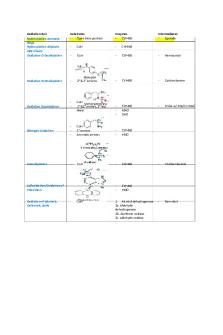IMF worksheet - Phase Changes and Calculations PDF

| Title | IMF worksheet - Phase Changes and Calculations |
|---|---|
| Author | Ama B |
| Course | Science |
| Institution | Catholic Theological Union |
| Pages | 2 |
| File Size | 73 KB |
| File Type | |
| Total Downloads | 27 |
| Total Views | 125 |
Summary
IMF assignments: IMF worksheet - Phase Changes and Calculations.
In the heating and cooling curves we learned that energy is absorbed by a substance as it melts or boils (vaporizes) and energy is released from a substance as it freezes or condenses....
Description
AP Chemistry IMF Worksheet: Phase Changes and Calculations NAME: __________________________________________________
In the heating and cooling curves we learned that energy is absorbed by a substance as it melts or boils (vaporizes) and energy is released from a substance as it freezes or condenses. The energies involved are the Heat of Vaporization (liquid gas) and the Heat of Fusion (solid liquid). These energies will be used as conversion factors: Heat of Vaporization or Heat of Fusion (melting) or Heat of Condensation Heat of Solidification of water of water Hvap =
2250 J gram
Hfus =
333 J gram
Do the following calculations. Show your equation for each problem. Box your answers. 1.
2.
Calculate the energy needed to vaporize… a)
15.0 g of water
b)
5.75 kg of water
c)
3.88 moles of water
Calculate the energy needed to melt… a)
23.0 g of water
b)
8.75 kg of water
c)
3.25 moles of water
Recall that, when calculating energy needed to bring a substance from one temperature to another temperature along its heating or cooling curve, that an energy calculation must be performed for every line segment of the curve. With this in mind, answer the following questions. (*Hint: Sketch a graph showing the processes that are occurring)
1. Ethanol, C 2H5OH, melts at -114°C and boils at 78°C. The enthalpy of fusion of ethanol is 5.02 kJ/mol, and its enthalpy of vaporization is 38.56 kJ/mol. The specific heats of solid and liquid ethanol are 0.97 J/g∙⁰C and 2.3 J/g∙⁰C, respectively. How much heat is required to convert 75.0 g of ethanol at -120°C to the vapor phase at 78°C?
2. Freon-11TM, which has the chemical formula CCl3F, has a normal boiling point of 23.8°C. The specific heats of CCl3F(l) and CCl3F(g) are 0.87 J/g∙⁰C and 0.59 J/g∙⁰C, respectively. The heat of vaporization for the compound is 24.75 kJ/mol. Calculate the heat required to convert 10.0 g of Freon-11 TM from a liquid at -50.0°C to a gas at 50.0°C....
Similar Free PDFs

Phase changes worksheet
- 2 Pages

Phase changes pogil - idek
- 9 Pages

Fluid calculations worksheet
- 12 Pages

Copy of Gizmo Phase Changes SE
- 5 Pages

Copy of Gizmo Phase Changes SE
- 5 Pages

IMF Practice
- 2 Pages

Chem- IMF Lab - IMF lab exercise
- 4 Pages

Pengertian IMF
- 1 Pages

Phase 1 and phase 2 reactions
- 8 Pages
Popular Institutions
- Tinajero National High School - Annex
- Politeknik Caltex Riau
- Yokohama City University
- SGT University
- University of Al-Qadisiyah
- Divine Word College of Vigan
- Techniek College Rotterdam
- Universidade de Santiago
- Universiti Teknologi MARA Cawangan Johor Kampus Pasir Gudang
- Poltekkes Kemenkes Yogyakarta
- Baguio City National High School
- Colegio san marcos
- preparatoria uno
- Centro de Bachillerato Tecnológico Industrial y de Servicios No. 107
- Dalian Maritime University
- Quang Trung Secondary School
- Colegio Tecnológico en Informática
- Corporación Regional de Educación Superior
- Grupo CEDVA
- Dar Al Uloom University
- Centro de Estudios Preuniversitarios de la Universidad Nacional de Ingeniería
- 上智大学
- Aakash International School, Nuna Majara
- San Felipe Neri Catholic School
- Kang Chiao International School - New Taipei City
- Misamis Occidental National High School
- Institución Educativa Escuela Normal Juan Ladrilleros
- Kolehiyo ng Pantukan
- Batanes State College
- Instituto Continental
- Sekolah Menengah Kejuruan Kesehatan Kaltara (Tarakan)
- Colegio de La Inmaculada Concepcion - Cebu






